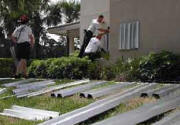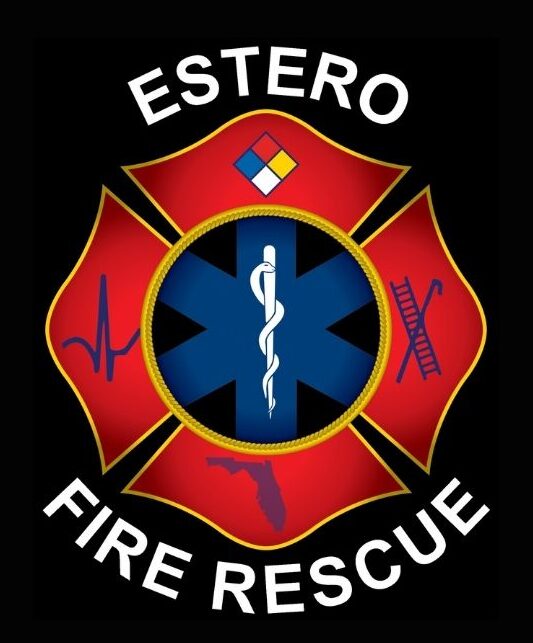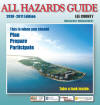What is a hurricane?
![hurr-photo[1]](/wp-content/uploads/hurr-photo1.jpg) A hurricane is a powerful tropical storm that measures several hundred miles in diameter.
A hurricane is a powerful tropical storm that measures several hundred miles in diameter.
Hurricanes have two main parts:
- The Eye of the hurricane, which is a calm area in the center of the storm. Usually measures about 20 miles in diameter, and has very few clouds.
- Wall of clouds that surrounds the calm eye. This is where the hurricane’s strongest winds and heaviest rain occur.
How do hurricanes form?
- Hurricanes need warm tropical oceans, moisture and light winds above them. If the right conditions last long enough, a hurricane can produce violent winds, incredible waves, torrential rains and floods.
- Hurricanes rotate in a counterclockwise direction around an “eye.”
- Hurricanes have winds of at least 74 miles per hour.
What’s the difference?
- Hurricane Defined surface circulation and a maximum sustained winds of 74 mph
- Tropical Storm Defined surface circulation and maximum sustained winds of 39-73 mph.
- Tropical Depression Defined surface circulation and maximum sustained winds of 38 mph.
Hurricane Categories
The Saffir-Simpson Scale is used by weather forecasters to grade hurricanes by their wind speed and potential damage.

Prevention and preparation are the best way to deal with any emergency. A good preparedness plan can make all the difference. This hurricane season, Estero Fire Rescue encourages all Lee County residents to plan and prepare well in advance. Here are some helpful tips to make your plan a great one:
- Put together an emergency kit that includes non-perishable food for up to three days. Don’t forget a manual can opener. In the event of power loss, the electric ones will not work
- Drinking water Have a minimum of one gallon of drinking water per person per day. Also juice boxes and soft drinks may be a welcome change
- Protect your home. Check the roof for loose shingles or those in need of repair. Protect exterior windows and secure all loose items around your home
- Medications. Make sure to have an ample amount of personal medications and prescriptions
- Cash on hand Have some cash on hand because you will not be able to access ATM’s in the event of a power failure
- Radios and batteries Have flashlights and a battery powered radio to get regular updates on the storm and recovery efforts. Make sure to have enough batteries on hand
- Evacuations What will you do in the event of an evacuation? Where will you go? Make sure to let relatives and friends know if you are leaving and where you can be reached
- Pets Shelters and some hotels do not take pets. If you have to evacuate, have a plan in place for your pets and remember to take supplies with you for them. Food, water, toys and medications.
For more details on planning for a hurricane or any emergency, click here for the Lee County Emergency Management All Hazard Guide.
Developing a Family Action Plan
 Here are some quick tips to help develop your family action plan for this hurricane season:
Here are some quick tips to help develop your family action plan for this hurricane season:
- A family action plan can keep residents safe and out of harm’s way in a severe weather event.
- Once the family develops and finalizes the action plan, be sure to practice it frequently.
- Discuss the type of hazards that could affect the family. Know the home’s vulnerability to storm surge, flooding, wind and tornado
- Determine if the home is located in storm surge evacuation zone. If so, know exactly where to go to reach safe shelter, and know how to get there
- If the home is located outside the storm surge evacuation zone, and the home is well constructed, its residents still need to have a hurricane plan.
- Locate a safe room or the safest areas in the home for each hurricane hazard. Sometimes the safest areas may not be in the home, but within the community.
- Determine escape routes from the home and designated meeting place nearby.
- Designate an out-of-state contact so all family members have a single point of contact.
- Make a plan now for what to do with pets if the family needs to evacuate. Most hurricane shelters do not accept pets.
- Post emergency telephone numbers. Make sure children know how and when to call 9-1-1.
- Review insurance coverage flood damage is not usually covered by homeowners insurance. Monitor a NOAA weather radio for official, real-time weather information.
Links:
- Need more help to develop your family plan? Visit the Florida Disaster website for an interactive way to prepare your family for hurricane season.www.floridadisaster.org
- Lee County’s All Hazard Guide is a valuable tool for not only hurricanes for all types of disasters, including wildfire. Visit this site for the on line version of the important guide. http://www.leegov.com/publicsafety/emergencymanagement/plan/ahg
- Click here for the National Weather Service Hurricane Center web site for the latest up to date information on storms: http://www.nhc.noaa.gov/index.shtml
- Live Tracking Online

